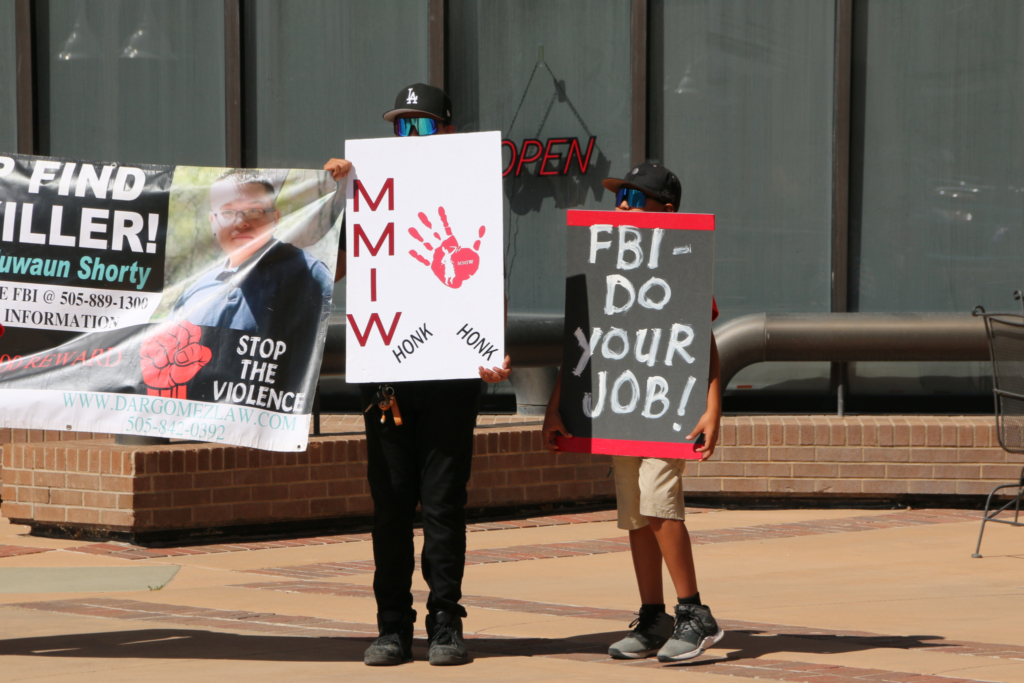Two boys hold signs at an Albuquerque protest against the crisis of missing and murdered Indigenous people on July 21, 2023. (Bella Davis/New Mexico In Depth)
This story was originally published by New Mexico In Depth
Neal, who is a member of the task force, told members it’s his understanding that agents sent to New Mexico will be working primarily in Farmington and Gallup.
“We have been able to make some great progress,” Neal said about working with agents sent to the state in the past year or two as part of the operation. “Unfortunately, because it’s been a short period of time, I feel like we make progress, and then [the agents are] gone, right? So this is a great opportunity to have them around for a little bit longer.”
During the last phase of the operation, in 2024, 50 FBI personnel worked in 10 field offices for four months, according to the agency, instead of six as called for this year.
The FBI’s Indian Country program had about 4,300 open investigations nationally at the start of fiscal year 2025, including over 900 death investigations, 1,000 child abuse investigations, and more than 500 domestic violence and adult sexual abuse investigations, according to the Justice Department.
The federal government has jurisdiction in prosecuting several types of violent crimes in Indian Country, including murder, kidnapping and sexual abuse.
‘Don’t give up’
Relatives of Indigenous people who have gone missing or been killed in the state spoke to the task force about their frustrations with a lack of law enforcement.
Becky Martinez, whose brother Calvin Martinez disappeared in 2019, told Neal that many Indigenous people go missing or are killed off reservations. That’s part of why the Justice Department created a regional outreach program focused on the crisis, which is the program he was hired under, Neal responded.
“I have worked on cases that have happened off the reservations where we use FBI resources,” Neal said. “The FBI has the cellular analysis survey team, for example. We’ve been able to help state and local law enforcement with cell site warrants, things like that, investigative techniques for cases where the FBI doesn’t have jurisdiction. But in those instances, it’s going to be an assist kind of situation.”
Since Julius Largo went missing near Morgan Lake in northwestern New Mexico in November, his family has organized searches for him, on their own and with help from a local nonprofit, his sister told the task force.
“We don’t see any FBI or criminal investigators until there’s a deceased body, and that’s what sucks,” Danielle Werito said. “With all these tips that we got, and I submitted to our detective, nothing is being done about it.”
Largo is a father and also has nieces and nephews who miss him, Werito said.
Mathilda Silago has been missing from Nageezi, also in northwestern New Mexico, since 2019. Her disappearance, Darrell Tsosie told task force members, has been “very challenging” for his and Mathilda’s daughter.
“I just want to tell every person out there online, those in attendance, again, you’re in my thoughts. You’re in my prayers. It is very challenging. Please don’t give up,” Tsosie said. “Let us keep each other in prayer and let us support one another. And for all of the law enforcement agencies out there, no more excuses. No more excuses. Please work together and let’s get these relatives home. Please.”
Gary Mike, whose daughter Ashlynne Mike, an 11-year-old Diné girl, was kidnapped and murdered on the Navajo Nation in 2016, also spoke to task force members.
“Please listen to all of these passionate people who represent their loved ones,” Mike said. “They are hurting. They’re looking for justice. They’re looking for their loved ones. Please understand, because I have been through that with my daughter Ashlynne.”
A 29-year-old man was sentenced to life imprisonment for her murder in 2017.
Also on Friday, New Mexico Department of Justice staffers shared updates to an online portal listing Indigenous people missing from New Mexico and the Navajo Nation. The portal now includes a tab displaying photos and stories of people who have been killed, submitted by their loved ones. There’s also a tab listing relevant community events.
Below are flyers for missing people who were mentioned by loved ones during public comment at Friday’s meeting.
Read the full article here


